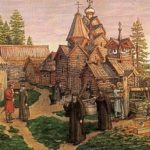10 Facts about the Pope in Rome
 In the history of mankind, there have been many cases when mysterious individuals tried to occupy the royal throne, declared themselves “savior of the nation” and “messiahs”. In some cases, it turns out that this is a historical fact, in other cases the event is not confirmed and turns out to be a beautiful legend. But here is the case that the pope was a woman – single and unique.
In the history of mankind, there have been many cases when mysterious individuals tried to occupy the royal throne, declared themselves “savior of the nation” and “messiahs”. In some cases, it turns out that this is a historical fact, in other cases the event is not confirmed and turns out to be a beautiful legend. But here is the case that the pope was a woman – single and unique.
Two John
The Roman Catholic Church claims that this event never happened. In the documents of the official Vatican there is no mention of Pope John VIII, who occupied the holy throne from 855 to 857. But historical science makes many arguments in favor of the fact that for two years the main Catholic in the early Middle Ages was a woman. For example, in the chronology of popes 15 years after one John VIII (i.e., papess), another pope with the same name is mentioned, elected in 872 and leading the Catholic world for ten years. Such a strangeness is explained by the fact that the occupation of the holy throne by a woman was a huge scandal, because of this all evidence was destroyed. Therefore, scientists had to work a lot in the archives to collect arguments in favor of the fact that Pope John was indeed the Pope.
Little preacher
Papess John in the “world” was Agnes, the daughter of a British missionary who was born illegitimate. The girl’s mother died very early, and her father began to take her with him on a journey with the goal of preaching Christianity among heretics. But the non-Christians did not want to save their lost souls and atone for sins, they often beat a man. One of these brawls ended very badly: Agnes’s father became a cripple. He could no longer go out into people and instruct unbelievers on the true path. And then the man drew attention to the excellent memory of his daughter, to her knowledge by heart of passages from the New Testament. Agnes replaced her father in religious affairs, she began to preach the word of God under his supervision. People came in droves to watch the little girl tell the gospel to them, it was a curiosity! When Agnes turned 14, her disabled father died. It was a wild Middle Ages with cruel mores. The girl was afraid that the men would encroach on her honor, and she decided to act very cunningly: she cut her hair, changed into men’s clothes and began to call herself John Langlois.
“Novice”
Two years later, the newly made John Langlois becomes a novice in the monastery. Benedictine monks studied ancient books there. Here, Agnes sharply changed her fate, falling in love with a Benedictine. The young monk also fell in love with a girl. They did not part from each other, they were always together: they had a meal together, read the Bible together, and they were always seen next to each other for walks in the garden. At first, this was not suspicious: the Benedictines thought that the two young monks made good friends. But it soon became clear that John was a girl, and she was a monk’s lover. Lovers started an escape from the monastery. They spent several years in English lands, then moved to France, where, under the name of Joanna Langlois, the girl again began to engage in theological sermons. After some time, the young couple left for Athens. In this Greek city, Agnes studied at a philosophical school. But here she suffered a great sorrow: her gentleman died of a serious and incurable disease. The girl grieved for a long time, then she wanted to change the situation and she moved to Rome. She decided to act according to the old scenario: to pretend to be a man, especially over the years, she really got used to this role.
In Rome
In the capital of the Christian world, Agnes John quickly managed to gain a place in the Roman Curia. The position of the notary brought her closer to the court of the pope. This post was reminiscent of the work of the secretary under the pope: she dealt with documents related to the external relations of the Holy See, the personal office of the pope, the financial side, and the adoption of petitions addressed to the pope. Meanwhile, Agnes struck everyone with her great knowledge of Christian doctrine. This surprised people because medieval people were mostly illiterate. People who were in those years in the service of the pope were also illiterate. Many of them could only sign papers, but could not read. The pope in those years was Leo the Fourth. He really liked the work of the new notary, so Agnes was soon elevated to the Cardinal dignity.
And soon the impossible happened: Leo the Fourth, dying, pointed to Cardinal Langlois as his successor. After the burial of Pope Agnes, whom everyone considered John Langlois, was elevated to the papal throne under the name of John VIII. The missionary’s daughter’s secret dream has come true! Legends say that the election of the popess in many corners of the globe was accompanied by signs: there were bloody rains, hurricanes swept, earthquakes occurred, locusts ate a lot of crops, leaving many villages without food. But the popess was not able to hide her sex for long. One of the young cardinals guessed that dad was a woman, and began to blackmail Agnes-John. But the girl was smart and answered the blackmailer with love. The young man also fell in love, a romance broke out between them. A love affair led to the pregnancy of the popess. The girl for some time was able to hide her increasing belly under clothes. But the time of birth was inexorably approaching.
The horrible birth of the popess
The sagan of Agnes, before giving birth, helped to hide the pregnancy. But almost nine months passed, and the fateful hour, which the girl was waiting with horror, was getting closer. At the time of birth, the popess wanted to take refuge in a secret place that only her lover would know about. But, unfortunately for Agnes, on November 20, 857, a procession was set up along Roman streets. This event according to Catholic canons was important, and the presence of the pope at the procession was mandatory. During the movement around Rome, the popess began to fight. She was terribly ill, but she tried not to show pregnancy and the terrible pain from prenatal contractions until the very end. The onset of labor coincided with a severe thunderstorm.
Pope suddenly in front of an amazed audience began to moan, cramp and died, and next to him lay a small corpse of a newborn baby. The people were terrified and attributed everything that happened to the machinations of Satan. Agnes was buried, a chapel was built in the place of her cemetery and a small statue of a baby was made with a child in her arms. But at the end of the medieval era, the then Pope Sixtus XVI ordered to remove the chapel and monument, to build up this place with new buildings, to clean all documents of the middle of the IX century in the archives of the Vatican. And in the Vatican in the Middle Ages, an unusual ritual was invented, indirectly confirming the existence of the popess.
A new tradition was that since the year 857, the popes have been examined, which was to confirm that the pope is a male person. For the survey, a unique chair was made with a hole in the middle. After the examination, the conclave of cardinals officially raised the pope to the holy dignity. The humiliating procedure was canceled only in 1520 by decree of Leo X. Perhaps the pope did this in connection with a large number of rumors about the mistresses and illegitimate children of cardinals and popes.



























